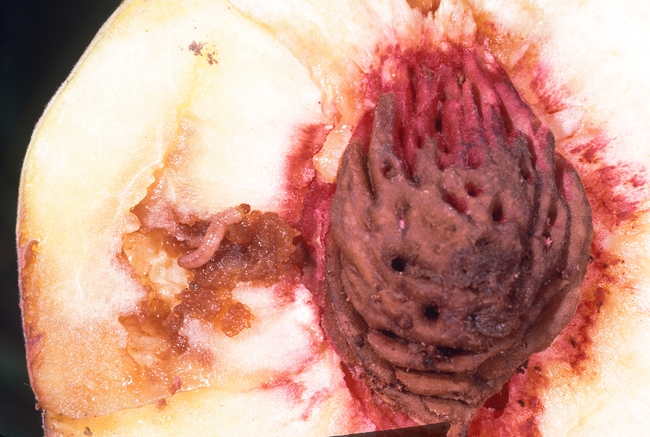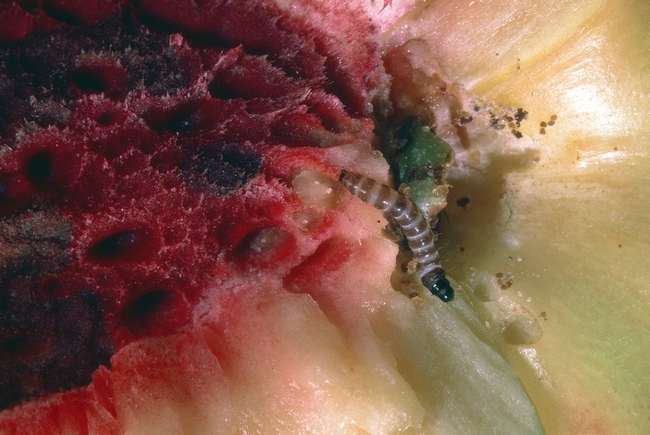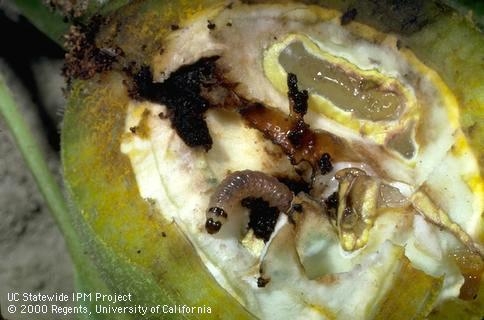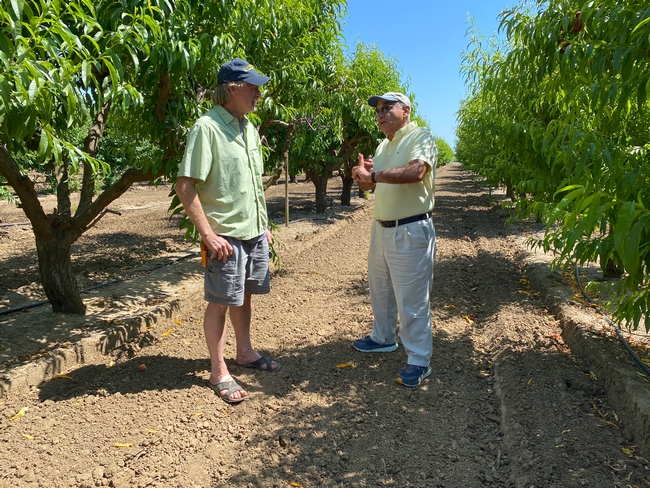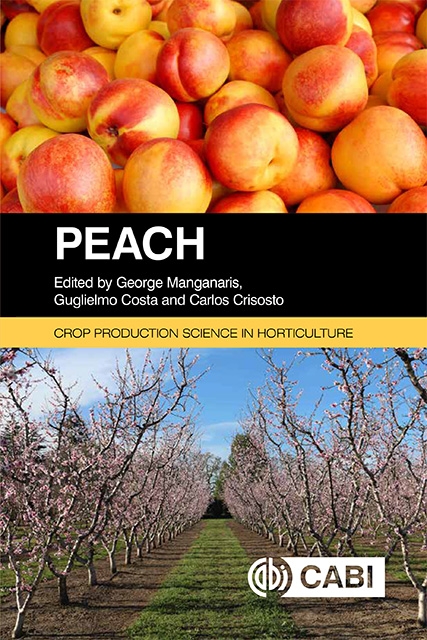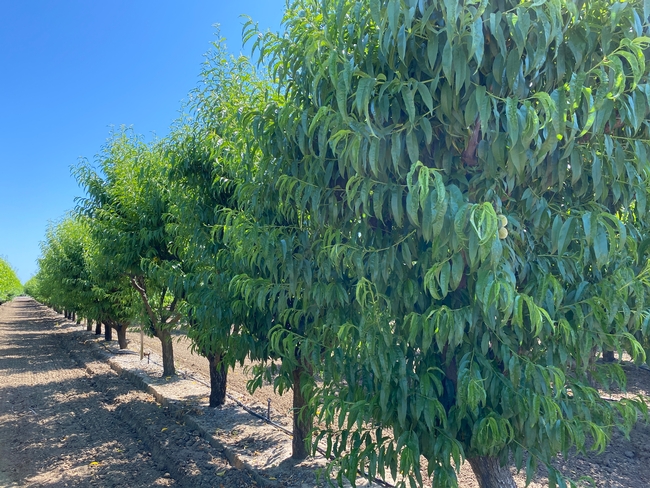Posts Tagged: peaches
Lawn-pocalypse! Surviving Drought
Ah, summer! The season of sunburns, pool parties, and… lawn droughts. If your once lush, green carpet now looks like a crunchy brown doormat, you're not alone. Let's dive into why your yard is staging a dramatic death scene and what you can do to...

Bermuda grass and weeds overtaking drought stressed turf grass.
Climate change to drive surge in insects that attack almonds, peaches, walnuts
UC study predicts three major pests to emerge earlier, produce more generations
As a result of climate change, the Golden State's farms are expected to face a surge in agricultural pests, which poses a threat to California's specialty crops industry. Populations of three major insect pests – codling moth, peach twig borer and oriental fruit moth — are projected to increase mainly due to rising temperatures, according to a study recently published in the journal “Science of the Total Environment” by a team of researchers at University of California Agriculture and Natural Resources and the U.S. Department of Agriculture California Climate Hub.
“These three pests are notorious for infesting most of the walnut, almond and peach orchards of California, causing extensive damages by reducing quality of fruits and nuts,” said study co-author Jhalendra Rijal, UC Cooperative Extension integrated pest management advisor and entomologist for Stanislaus, San Joaquin and Merced counties.
Climate change can lead to shifts in the timing of seasons, including warmer winters, earlier springs and hotter summers, and these conditions can disrupt the natural life cycles of pests.
The California research is supported in part by USDA's National Institute of Food and Agriculture. NIFA National Program Leader Amy Ganguli said the California project is a strong example of the work being done through AFRI's Extension, Education & USDA Climate Hubs Partnership.
“A key element of this grant program to link critical research findings like this with timely education and outreach efforts to producers and the public to encourage nimble responses to the challenges climate change pose,” Ganguli said.
The new research, led by Prakash Jha, UC Agriculture and Natural Resources assistant project scientist based at UC Merced, compared pest populations in recent and future climates. The scientists used temperature projections from the latest generations of scientific models to predict the potential impact of climate change on codling moth (Cydia pomonella), peach twig borer (Anarsia lineatella) and oriental fruit moth (Grapholita molesta). Before using the model, the model predictions were verified using field data of these insect pests from various parts of the Central Valley.
The UC study revealed that due to increases in temperature, these insects are expected to appear up to 28 days earlier in the spring and the time between generations is expected to shorten by up to 19 days. The changes may be gradual, but the study predicts that we may see up to a half-generation of these pests added within the next 20 to 30 years.
The increase in these pest populations poses a serious threat for future pest management, which would subsequently affect the state's economy and employment related to specialty crops, warns Rijal.
“Codling moth is the primary pest of California's walnuts, which occupies over 365,000 acres,” Rijal said. “Similarly, peach twig borer and oriental fruit moth are two major economic pests of peaches. Growers must control almost every generation of these pests to protect the fruit.
“Additional generations of these pests within the same growing season will likely increase crop damage. It certainly increases the number of sprays needed to control these pests, increasing the production cost for growers. Plus, more use of insecticides has consequences for beneficial insects and the environment.”
Growers may need to adapt their pest management strategies to address the impact of climate change on these pests.
For years, the UC Integrated Pest Management guidelines have suggested putting oriental fruit moth traps out in peach orchards by Feb. 15 in the San Joaquin Valley and Feb. 20 in the Sacramento Valley.
“In the last seven years, likely due to warmer winter, as suggested in this study, we observed the beginning of the moth's activity in traps (also called biofix) as early as Feb. 14,” Rijal said, “meaning that the trap placement date must move earlier to capture the first moth activity. We are revising the guidelines to change the trap placement date to Feb. 7 for the entire Central Valley.”
Developing a holistic climate-smart pest management strategy will build resilience, Jha said. This approach combines pest control with prevention and reduction, such as planting pest-resistant crop varieties, sanitizing the orchards during the winter, harvesting early to avoid later pest generation infestation, using biological control such as natural enemies, and deploying mating disruption techniques.
“More importantly, adoption of pest forecasting – including the long-term prediction and short-term potential outbreak, pest-scouting and early detection – will be essential to combat the growing threat posed by these pests,” Jha said.
Research will be crucial to provide growers support and guidance about the latest developments in pest management and how to adapt their practices.
“Climate change impacts on pests and resulting impacts on agricultural production are significant but not often researched or quantified,” said Tapan Pathak, UC Cooperative Extension specialist in climate adaptation in agriculture based at UC Merced.
“Information from this research will not only help farmers to understand impacts for strategic planning, but also will inform the agricultural industry to invest in making varieties more resilient to these damaging agricultural pests,” Pathak added. “We will use this information to update the CalAgroClimate tool, which informs farmers on the progress of these pests during the season so that they can take steps for effective pest management.”
Ganguli added the partnership between the University of California and the California Climate Hub embodies the goal of this funding program.
“The incorporation of this research into the existing CalAgroClimate decision support tool accelerates the ability of this information to be publicly used in the development of appropriate pest management or adaptation strategies,” she said.
In addition to Jha, Rijal and Pathak, the study was co-authored by Ning Zhang, Lauren E. Parker and Steven Ostoja of UC Davis Institute of the Environment and U.S. Department of Agriculture California Climate Hub.
The article “Climate change impacts on insect pests for high value specialty crops in California” can be accessed for free online at https://doi.org/10.1016/j.scitotenv.2023.167605.
Dec. 8, 2023: This story was updated to add comments by NIFA National Program Leader Amy Ganguli.
Peach book guides growing quality fruit from planting to beyond harvest
Crisosto and team publish handbook for growing peaches and maintaining quality for canning
In an experimental orchard a few miles west of the UC Davis campus, Thomas Gradziel plucked a nearly ripe nectarine from one of the trees. He whipped out a pocketknife and sliced off juicy chunks for Carlos Crisosto to taste. Both are orchard crops experts in the UC Davis Department of Plant Sciences, and both love peaches.
The two made appreciative sounds as they pulled the fruit's flavor across their palates, discussed how this nectarine variety compared to other varieties, and quickly turned to details of production and orchard management.
Crisosto and Gradziel have poured decades of experience with orchard fruits into creating “Peach,” a landmark handbook on cultivation and postharvest considerations published by CABI. The book is part of the international academic publisher's Crop Production Science in Horticulture series.
Peach gives growers basic information that can reduce their production risks, boost profits and help them face issues such as climate change and a shifting world market, CABI writes in the book's description.
“This will still be the definitive text for probably the next 20 years,” said Carlos Crisosto, who is one of the book's editors and authors. He is both a distinguished professor in the UC Davis Department of Plant Sciences and UC Cooperative Extension specialist in consumer quality and postharvest technology in UC Agriculture and Natural Resources.
Chapters also cover rootstock, cultivars, water management, fertilization, fruit growth and thinning, testing for maturity, and supply chain management after harvest. Several more chapters cover pests and diseases, maintaining fruit quality, nutritional aspects and canning.
“This book was a pleasure to contribute to, as it includes information from expert colleagues plus exciting new ideas and applications from our recent researchers,” said Gradziel, a UC Davis professor and plant breeder.
In California, farmers cultivated 36,800 acres of peaches, producing 505,000 tons of fruit worth more than $378 million in 2021. While the crop ranks 23rd in the state, based on cash receipts, California is the No. 1 producer of peaches for the entire United States, according to the California Department of Food and Agriculture.
Crisosto teamed up with colleagues George Manganaris in Cyprus and Guglielmo Costa in Italy to edit this volume, which takes an international look at a growing industry.
Fun fact mentioned in Peach: Nectarines are a peach without the fuzz, a genetic variation. “Most people don't know that!” Crisosto said with a laugh.
Peach contains more fun facts: Peaches are a member of the rose family, China is the world's largest producer of the fruit (growing 60% of the global crop), and industry leaders yearn for trees with a flat canopy so the fruit would ripen all at about the same time and could be harvested easily by machine, reducing the pressure of finding people to pick the fruit by hand.
Peach is available as an e-book and in paperback. Both cost $80 each.
To preview and order the e-book chapters, visit bit.ly/PeachBook. Get a 20% discount with the code CCAB20 during online checkout. The 424-page paperback can be ordered at https://bit.ly/PeachPaperback.
The publisher's sales staff for North America and South America are based in Herndon, Virginia, and can be reached at StylusMail@PressWarehouse.com, (703) 661-1581 or (800) 232-0223.
This Peach book complements our previous publication, “Manual on postharvest handling of Mediterranean tree fruits and nuts,” Crisosto said. “These two publications contain state-of-the-art production and postharvest information that support our research and information centers, UC ANR mission and our academic teaching.”
Climate-Change Resources
University of California UC ANR Green Blog (Climate Change and Other Topics) https://ucanr.edu/blogs/Green/index.cfm?tagname=climate%20change (full index)
Examples:
- Save Trees First: Tips to Keep Them Alive Under Drought https://ucanr.edu/b/~CdD
- Landscaping with Fire Exposure in Mind: https://ucanr.edu/b/~G4D
- Cities in California Inland Areas Must Make Street Tree Changes to adapt to Future Climate https://ucanr.edu/b/~oF7
Drought, Climate Change and California Water Management Ted Grantham, UC Cooperative Extension specialist (23 minutes) https://youtu.be/dlimj75Wn9Q
Climate Variability and Change: Trends and Impacts on CA Agriculture Tapan Pathak, UC Cooperative Extension specialist (24 minutes) https://youtu.be/bIHI0yqqQJc
California Institute for Water Resources (links to blogs, talks, podcasts, water experts, etc.) https://ciwr.ucanr.edu/California_Drought_Expertise/
UC ANR Wildfire Resources (publications, videos, etc.) https://ucanr.edu/News/For_the_media/Press_kits/Wildfire/ (main website)
-UC ANR Fire Resources and Information https://ucanr.edu/sites/fire/ (main website)
-Preparing Home Landscaping https://ucanr.edu/sites/fire/Prepare/Landscaping/
UC ANR Free Publications https://anrcatalog.ucanr.edu/ (main website)
- Benefits of Plants to Humans and Urban Ecosystems: https://anrcatalog.ucanr.edu/pdf/8726.pdf
-Keeping Plants Alive Under Drought and Water Restrictions (English version) https://anrcatalog.ucanr.edu/pdf/8553.pdf
(Spanish version) https://anrcatalog.ucanr.edu/pdf/8628.pdf
- Use of Graywater in Urban Landscapes https://anrcatalog.ucanr.edu/pdf/8536.pdf
- Sustainable Landscaping in California https://anrcatalog.ucanr.edu/pdf/8504.pdf
Other (Non-UC) Climate Change Resources
Urban Forests and Climate Change. Urban forests play an important role in climate change mitigation and adaptation. Active stewardship of a community's forestry assets can strengthen local resilience to climate change while creating more sustainable and desirable places to live. https://www.fs.usda.gov/ccrc/topics/urban-forests
Examining the Viability of Planting Trees to Mitigate Climate Change (plausible at the forest level) https://climate.nasa.gov/news/2927/examining-the-viability-of-planting-trees-to-help-mitigate-climate-change/
Reports and other information resources coordinated under the auspices of the United Nations and produced through the collaboration of thousands of international scientists to provide a clear and up to date view of the current state of scientific knowledge relevant to climate change. United Nations Climate Action
Scientific reports, programs, action movements and events related to climate change. National Center for Atmospheric Research (National Science Foundation)
Find useful reports, program information and other documents resulting from federally funded research and development into the behavior of the atmosphere and related physical, biological and social systems. Search and find climate data from prehistory through to an hour ago in the world's largest climate data archive. (Formerly the "Climatic Data Center") National Centers for Environmental Information (NOAA)
Think tank providing information, analysis, policy and solution development for addressing climate change and energy issues (formerly known as the: "Pew Center on Global Climate Change"). Center for Climate & Energy Solutions (C2ES)
Mapping Resilience: A Blueprint for Thriving in the Face of Climate Disaster. The Climate Adaptation Knowledge Exchange (CAKE) was launched in July 2010 and is managed by EcoAdapt, a non-profit with a singular mission: to create a robust future in the face of climate change by bringing together diverse players to reshape planning and management in response to rapid climate change. https://www.cakex.org/documents/mapping-resilience-blueprint-thriving-face-climate-disaster
Cal-Adapt provides a way to explore peer-reviewed data that portrays how climate change might affect California at the state and local level. We make this data available through downloads, visualizations, and the Cal-Adapt API for your research, outreach, and adaptation planning needs. Cal-Adapt is a collaboration between state agency funding programs, university and private sector researchers https://cal-adapt.org/
Find reports, maps, data and other resources produced through a confederation of the research arms of 13 Federal departments and agencies that carry out research and develop and maintain capabilities that support the Nation's response to global change. Global Change (U.S. Global Change Research Program)
The Pacific Institute is a global water think tank that combines science-based thought leadership with active outreach to influence local, national, and international efforts to develop sustainable water policies. https://pacinst.org/our-approach/
Making equity real in climate adaptation and community resilience policies and programs: a guidebook. https://greenlining.org/publications/2019/making-equity-real-in-climate-adaption-and-community-resilience-policies-and-programs-a-guidebook/
Quarterly CA Climate Updates and CA Drought Monitor Maps (updated each Thursday) https://www.drought.gov/documents/quarterly-climate-impacts-and-outlook-western-region-june-2022
Drought focus of Water Resources IMPACT magazine special issue
UC ANR experts address emotional toll of drought
Preparing the American West for prolonged drought is the focus of a double issue of Water Resources IMPACT magazine. The California Water Commission staff are guest editors for this special open-access edition of the magazine, which is published by the American Water Resources Association.
Faith Kearns, academic coordinator of University of California Agriculture and Natural Resources' California Institute for Water Resources, is among the authors delving into how drought impacts people and the environment and how we can better prepare for the inevitable.
The first issue, published on Feb. 14, focuses on water scarcity issues confronting California and the ways these issues affect different sectors.
In “Trauma, Care, and Solidarity: Addressing the Emotional Toll of Chronic Drought,” Kearns highlights the effects of drought on mental health. She points to the spike in suicide hotline calls when wells ran dry in Southeast Asian communities in California's Central Valley.
By listening to Southeast Asian farmers, Ruth Dahlquist-Willard and Michael Yang of UC Cooperative Extension were able to “lighten the load” for them by providing pragmatic support, Kearns writes.
“The scale of some of these highly emotional issues – drought, wildfires, climate change – can make them seem incredibly difficult, if not impossible, to deal with,” Kearns said. “At the same time, they are affecting everyone living in the western U.S. on a daily basis. I wanted to highlight and provide models based on work that people – whether they are researchers, clinical psychologists, or Cooperative Extension advisors – are doing right now to ease the way.”
The authors who contributed to the double issue are a diverse array of Tribal experts, academics, nongovernmental organization thought-leaders, water managers and water policy influencers, each of whom brings their own perspective on the topic of drought. Their expertise and perspectives in climate science, water policy and water management will help inform drought-related decision-making and support policies that better prepare the state to thrive during periods of prolonged water scarcity.
In addition to Kearns, the first issue includes articles contributed by:
- Samantha Stevenson, University of California, Santa Barbara
- Jay Lund, University of California, Davis
- Ron Goode, North Fork Mono Tribe
- Andy Fecko, Placer County Water Agency
- Jeff Mount, Public Policy Institute of California, and Ted Grantham, University of California, Berkeley/UC Cooperative Extension
- Nat Seavy and Karyn Stockdale, National Audubon Society
- Kjia Rivers, Community Water Center
- Cannon Michael, Bowles Farming
- Michelle Reimers, Turlock Irrigation District
The January/February edition of Water Resources IMPACT magazine can be accessed, free of charge, on the American Water Resources Association website at https://www.awra.org under “Publications.”
The second issue, to be published in March, will focus on drought response, considering the options for adaptation. This two-part series complements the Commission's work on strategies to protect communities and fish and wildlife in the event of a long-term drought.

